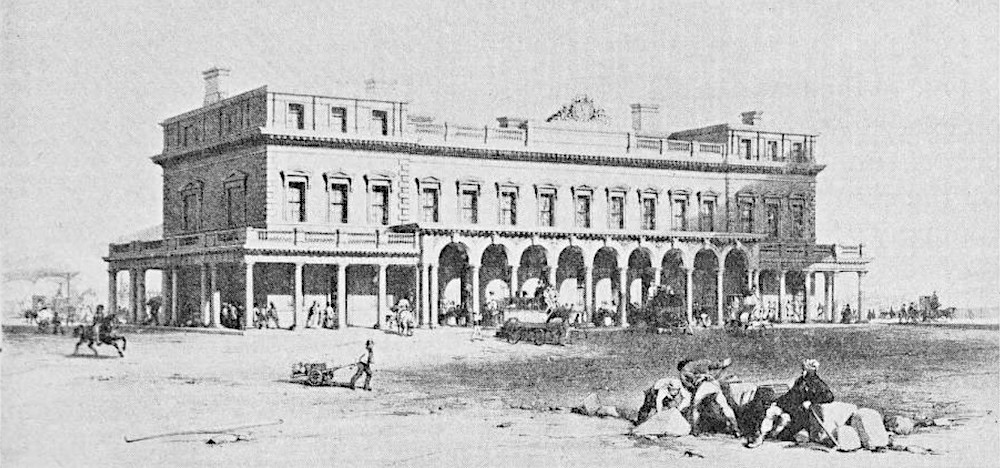
Brighton Station, 1841. Source: Marshall 269.
Brighton Station, the terminus of the London & Brighton Railway (which became the London, Brighton & South Coast Railway from 1846), opened September 1841. It was designed by David Mocatta, and stands on Queen's Road, Brighton. [Click on this and the following images to enlarge them.]
Mocatta designed altogether thirteen stations for the London & Brighton Railway, built 1839-41. These were in various styles, but, in general, writes Jack Simmonds, he "gave careful thought to evolving designs that should be economical, functionally sound, and comfortable for passengers. His roofed-in platforms, for example, protected them well against wind, being furnished either with alcoves or with screens at each end" (33). Particular care would have been lavished on the terminus which overlooked this fashionable seaside town. At the time, the Brighton Gazette was full of praise, describing its neo-classical building as "a beautiful structure," which, "with the iron sheds in the rear" could not "suffer from a comparison with any railway terminus in existence. The offices and waiting rooms are most commodious, and are furnished with every convenience for passengers" (qtd. in Arscott 17).
But what Caroll Meeks describes as an "early head-type with shed" station (30) would soon need extending, and its elegant façade was too plain for the later Victorians, who added the adornments seen now, with their typical seaside-style ironwork: "it was enlarged, and the platforms extended, in 1852-4; the train sheds date from 1882-3 and were designed by H.E. Wallis, and the canopy in front of the station is of the same date" (listing text).

The crowded forecourt of Brighton Railway Station in recent times.
The façade (topped by the clock, which was restored in more recent times) was obscured by the canopy of the 1882-83 rebuild. The famous lacy ironwork, matched by the design of the street lights, all dates from this later period, as do the roofs of the engine sheds designed by Wallis. The bus station outside also obscures Mocatta's original approach.


Left: Main entrance. Right: Engine sheds at rear.
In the nineteenth century, the station served not only crowds of excursionists but many of the most distinguished Victorians of all walks of life, including Queen Victoria herself, some of them bound for the Royal Pavilion, others for grand hotels like the Metropole on the seafront. The concourse is now thronged with students bound for the large local campuses of Brighton and Sussex Universities — many requiring another train-ride across the Brighton or London Road Viaduct, on the branch line stopping at Falmer on the way to Lewes.

Scan and photographs by the author. You may use the images without prior permission for any scholarly or educational purpose as long as you (1) credit the person who scanned the image / photogrpaher, and (2) link your document to this URL in a web document or cite the Victorian Web in a print one.
Bibliography
Arscott, David. Brighton in the News. Swindon: Sutton Publishing (for W.H. Smith), 2002.
"Brighton Station including Train Sheds." Historic England. Web. 18 May 2024.
Marshall, C.F. Dendy. A History of the Southern Railway. London: The Southern Railway Company, 1936. Internet Archive. Web. 18 May 2024.
Meeks, Caroll L.V. The Victorian Railroad Station: An Architectural History. New York: Dover, 1995.
Simmons, Jack. The Victorian Railway. Pbk ed. London: Thames & Hudson, 1995.
Created 20 November 2006; last modified 18 May 2024